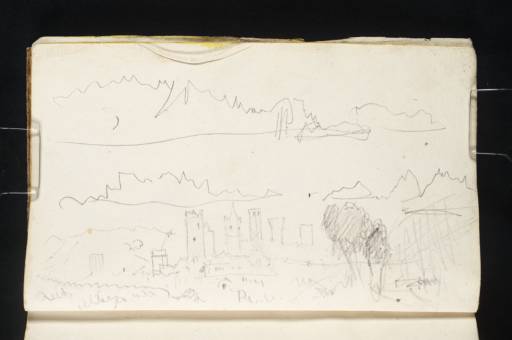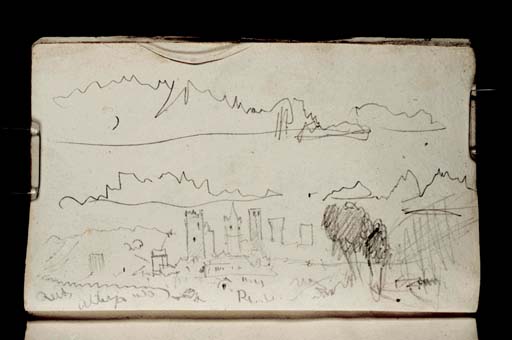Joseph Mallord William Turner Albenga from the River Centa; Two Views of the Estérel Coast, from the Sea 1828
Image 1 of 2
Joseph Mallord William Turner,
Albenga from the River Centa; Two Views of the Estérel Coast, from the Sea
1828
Folio 3 Verso:
Albenga from the River Centa; Two Views of the Estérel Coast, from the Sea 1828
D21138
Turner Bequest CCXXXI 3a
Turner Bequest CCXXXI 3a
Pencil on white wove paper, 113 x 174 mm
Inscribed in pencil by Turner ‘Reeds’ and ‘Albenga’ bottom left, ‘R[?iver]’ bottom centre, and ‘Red’ and ‘W’ within lower sketch
Inscribed in pencil by Turner ‘Reeds’ and ‘Albenga’ bottom left, ‘R[?iver]’ bottom centre, and ‘Red’ and ‘W’ within lower sketch
Accepted by the nation as part of the Turner Bequest 1856
References
1909
A.J. Finberg, A Complete Inventory of the Drawings of the Turner Bequest, London 1909, vol.II, p.708, CCXXXI 3a, as ‘Town with mountains’.
As Turner’s inscription in the bottom-left corner indicates, the subject of the topographical landscape at the bottom of the page is Albenga, a small city in the Liguria region of Italy, known as the ‘la città delle cento torri’ (city of a hundred spires).1 The artist’s viewpoint appears to be on or near the old bridge across the River Centa (present-day Ponte Rosso), looking north-west towards the city’s historic centre with its closely grouped towers, including the campanile of the cathedral of San Michele di Arcangelo, the Palazzo Vecchio and the Torre del Comune. On the left, is the shorter Romanesque corner tower of the Palazzo Peloso Cepolla, which Turner has annotated with colour notes to denote the ‘red’ brick and ‘w[hite]’ top. A similar, more detailed study of the same topography can be found on folio 53 verso (D21236).
For further sketches of Albenga, see folios 2 verso, 29 verso and 52 verso–54 recto (D21136, D21188, D21234–D21237).
Two further sketches at the top of the page appears to represent parts of the Estérel coast between Fréjus and Cannes.2 Turner sketched the coastline from a boat and these rough profile drawings include the outlines of small Mediterranean islands. The small crescent stroke towards the top left, below the jagged upper skyline, seems to be Turner’s customary indication of a waxing moon, probably in relation to the selectively shaded view of Albenga.
Technical notes:
There is a thin, curved sliver missing from the top (outer) edge. It is likely part of the unfinished edge of the original sheet folded and trimmed to form the gathering; compare the slight irregularity of folio 4 (D21139–D21140).
Nicola Moorby
March 2017
Revised by Hannah Kaspar
November 2024
How to cite
Nicola Moorby, ‘Albenga from the River Centa; Two Views of the Estérel Coast, from the Sea 1828’, catalogue entry, March 2017, revised by Hannah Kaspar, November 2024, in David Blayney Brown (ed.), J.M.W. Turner: Sketchbooks, Drawings and Watercolours, Tate Research Publication, February 2025, https://www


